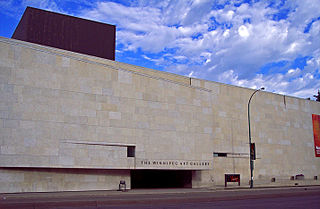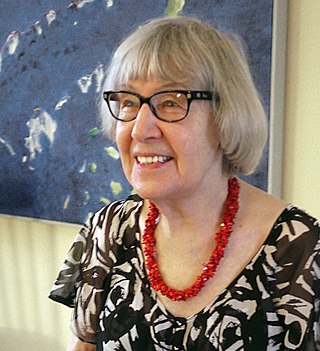Related Research Articles

The Winnipeg Art Gallery (WAG) is an art museum in Winnipeg, Manitoba, Canada. Its permanent collection includes over 24,000 works from Canadian, Indigenous Canadian, and international artists. The museum also holds the world's largest collection of Inuit art. In addition to exhibits for its collection, the museum has organized and hosted a number of travelling arts exhibitions. Its building complex consists of a main building that includes 11,000 square metres (120,000 sq ft) of indoor space and the adjacent 3,700-square-metre (40,000 sq ft) Qaumajuq building.

Betty Roodish Goodwin, was a multidisciplinary Canadian artist who expressed the complexity of human experience through her work.
Colin Campbell was a Canadian video artist.

Rebecca Belmore is a Canadian interdisciplinary Anishinaabekwe artist who is notable for politically conscious and socially aware performance and installation work. She is Ojibwe and a member of Obishikokaang. Belmore currently lives in Toronto, Ontario.
KC Adams is a Cree, Ojibway, and British artist and educator based in Winnipeg, Manitoba.

Gathie Falk is a Canadian painter, sculptor, installation and performance artist based in Vancouver, British Columbia. Since the 1960s, she has created works that consider the simple beauty of everyday items and daily rituals.
Mentoring Artists for Women's Art (MAWA) is a feminist visual arts education center based in Winnipeg, Manitoba. Created in 1984, this non-profit organization encourages and supports the intellectual and creative development of women in the visual arts by providing an ongoing forum for education and critical dialogue.
The Manitoba Arts Council is a provincial crown corporation whose purpose is to promote the arts. The Council awards grants to professional artists and arts organizations in Manitoba in all art forms; it also provides related creative activity such as arts education.
Bev Pike is a Winnipeg-based visual artist who paints large cinematic baroque landforms. Grottesque, her current work on climate catastrophe, is a series of interconnected underground sanctuaries based on seventeenth century English shell grottos.
Diane Whitehouse is a Canadian painter, professor and art activist.
Diana Thorneycroft is a Canadian artist based in Winnipeg, Manitoba, whose work has exhibited nationally and internationally. She works primarily in photography, drawing, and sculpture/installation and makes photographs of staged dioramas to explore sexuality and national identity, and even, national icons such as the Group of Seven. Her work blurs the lines between gendered bodies by employing phalluses. She is also an educator: she worked as a sessional instructor at the University of Manitoba's School of Art for 25 years.
Tania Willard is an Indigenous Canadian multidisciplinary artist, graphic designer, and curator, known for mixing traditional Indigenous arts practices with contemporary ideas. Willard is from the Secwepemc nation, of the British Columbia interior, Canada.
Renée Van Halm is a Canadian contemporary visual artist born in Haarlemmermeer, the Netherlands (1949) and immigrated to Canada in 1953.

Ulayu Pingwartok was a Canadian Inuk artist known for drawings of domestic scenes and nature.
Colleen Cutschall, also known as Sister Wolf, is an Oglala-Sicangu Lakota artist from Pine Ridge, South Dakota, who works in Manitoba.
Anne Ramsden is a Canadian artist who has exhibited widely in Canada. She currently lives and works on Gabriola Island, British Columbia on the traditional and unceded territory of the Snuneymuxw First Nation.
Shelagh Keeley is a Canadian multi-disciplinary artist. She is best known for her drawings and immersive installations, but her practice also includes photography, film, collaborative performances, and artist's books.
Luanne Martineau is a contemporary, multimedia Canadian artist best known for her hand-spun and felted wool sculptures. Her work engages with social satire as well as feminist textile practice.

Daina Warren is a Canadian contemporary artist and curator. She is a member of the Montana Akamihk Cree Nation in Maskwacis, Alberta. Her interest in curating Aboriginal art and work with Indigenous artists is at the forefront of her research.
Jeff Thomas is an Onondaga Nation photographer, curator, and cultural theorist who works and lives in Ottawa, Ontario.
References
- ↑ "Aganetha Dyck, University of Manitoba Archives & Special Collections". Archived from the original on 2018-02-20. Retrieved 2018-02-19.
- 1 2 3 4 5 6 7 8 Yeo, Marian (1987). "Sharron Zenith Corne, Aganetha Dyck, Esther Warkov: Three Manitoba Artists". Woman's Art Journal. 8 (1): 33–39. doi:10.2307/1358338. JSTOR 1358338.
- 1 2 3 4 5 6 7 8 9 10 "Aganetha Dyck fonds – University of Manitoba Archives". umlarchives.lib.umanitoba.ca. Archived from the original on 2018-03-04. Retrieved 2018-03-03.
- 1 2 3 4 5 6 7 8 Brennan, Brian (2008). "Aganetha Dyck – Homage". Galleries West. 7 (2). T2 Media Inc. Archived from the original on 16 March 2015. Retrieved 23 September 2015.
- ↑ White, Laura (2013). Herstory: Art by Women from the University of Winnipeg Collection. Winnipeg, Canada: Leamarc. p. 23. ISBN 978-0-9921187-0-9.
- 1 2 "Aganetha Dyck". National Gallery of Canada. Archived from the original on 17 July 2015. Retrieved 24 September 2015.
- ↑ "LOOK AT THIS: Aganetha Dyck's Sculptural Collaborations – With Bees". George stroumboulopoulos Tonight. Canadian Broadcasting Corporation. Archived from the original on 1 August 2014. Retrieved 25 October 2015.
- 1 2 3 Moore, Shannon (September 28, 2015). "A Poignant Farewell: Aganetha Dyck at the Tom Thomson Gallery". National Art Gallery of Canada. NGC Magazine. Archived from the original on 8 November 2015. Retrieved 25 October 2015.
- ↑ White, Laura (2013). Herstory: Art by Women from the University of Winnipeg Collection. Winnipeg, Manitoba: Leamarc. p. 25. ISBN 978-0-9921187-0-9.
- ↑ "2009 Exhibitions". Archived from the original on 2018-03-17.
- ↑ "Thunderstruck: Physical Landscapes at Âjagemô". Canada Council for the Arts. Archived from the original on 2019-03-24. Retrieved 2019-03-24.
- ↑ "Aganetha Dyck 2006 Manitoba Arts Award of Distinction". Manitoba Arts Council. Manitoba Arts Council. Archived from the original on 10 October 2015. Retrieved 25 October 2015.
- ↑ Van Eijnsbergen, Ellen; Cane, Jennifer (2017). The Ornament of a House: 50 years of Collecting. Burnaby, British Columbia, Canada: Burnaby Art Gallery. p. 111. ISBN 978-1-927364-23-9.
- 1 2 "Aganetha Dyck – Surreal Transformations". Akimbo. Archived from the original on 4 March 2016. Retrieved 25 October 2015.
- ↑ "WAC Arts Awards Winners For 2014". Winnipeg Arts Council. Winnipeg Arts Council. Archived from the original on 7 September 2015. Retrieved 25 October 2015.
- ↑ Martens, Darrin; Laurence, Robin (2009). Aganetha Dyck: Collaborations. Burnaby Art Gallery. ISBN 978-0980996203.
- ↑ "Aganetha Dyck: Guest Workers – Confederation Centre of the Arts". confederationcentre.com. Archived from the original on 2019-03-01. Retrieved 2019-03-01.
- ↑ "Past Exhibitions in the Main Gallery". ART GALLERY OF ALGOMA. Archived from the original on 2019-03-01. Retrieved 2019-03-01.
- ↑ "You've Really Got a Hold on Me". www.oakvillegalleries.com. Archived from the original on 2019-03-01. Retrieved 2019-03-01.
- ↑ "Aganetha Dyck | Honeybee Alterations | Ottawa School of Art / École d'Art d'Ottawa". artottawa.ca. Archived from the original on 2018-07-05. Retrieved 2019-03-01.
- ↑ "Cross Pollination". www.516arts.org. Archived from the original on 2019-03-01. Retrieved 2019-03-01.
- ↑ Gallery, Kamloops Art. "AlterNation". Kamloops Art Gallery. Archived from the original on 2019-03-01. Retrieved 2019-03-01.
- ↑ "apexart :: Animal Intent :: Emily Falvey". apexart.org. Archived from the original on 2019-03-01. Retrieved 2019-03-01.
- 1 2 "Displacement". Galleries West. 2019-03-07. Retrieved 2020-03-05.
- ↑ "Opening Reception: Something More Than Nothing". Evergreen. Retrieved 2020-03-05.
- ↑ "Aganetha Dyck". www.gallery.ca. Retrieved 2020-03-05.
- ↑ "Hive Drawing #2 | Art Gallery Collections". collections.burnabyartgallery.ca. Retrieved 2020-03-05.
- ↑ "Dunlop Art Gallery". collection.dunlopartgallery.org. Retrieved 2020-03-05.
- ↑ "Aganetha Dyck – Colours: to be washed separately". kelownaartgallery.pastperfectonline.com. Retrieved 2020-03-05.
- ↑ "DYCK, Aganetha – Button Box, 1984". www.oakvillegalleries.com. Retrieved 2020-03-05.
- ↑ "G-92-192 a-r Pocket Books for the Queen Bee Aganetha Dyck » WAG". WAG. Retrieved 2020-03-05.
- ↑ "The Glenbow Museum > Collections Search Results". ww2.glenbow.org. Retrieved 2020-03-05.
- ↑ "Art Gallery of Guelph". Art Gallery of Guelph. Retrieved 2020-03-05.